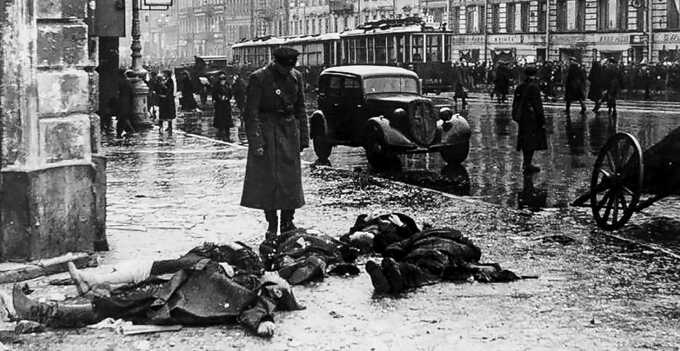In the besieged city of Leningrad, some people consumed corpses, while others indulged in caviar.
St. Petersburg is getting ready to celebrate the 80th anniversary of the breakthrough. blockIn January 1943, a terrible famine resulted in over 80,000 deaths in Leningrad. However, they endured starvation in the lower part of the city. blockthe bottom of the city is far from everything.
Start date blockThe beginning of the siege is considered September 8, 1941, when the German and Finnish troops surrounded Leningrad. At the same time, for the people of Leningrad blockYes, it began at the end of August, after the Sever group troops, having taken control of the Mga station, cut off the railway connection between Leningrad and the rest of the country. This led to around 40,000 people gathering at the stations, waiting for evacuation to the east. Furthermore, the situation worsened because approximately 300,000 refugees had arrived in Leningrad from the Baltic states, as well as the Pskov and Novgorod regions since the start of the war. Consequently, the nearly three-million population of the city immediately increased by 10%.
Now it's clear that neither the country's leadership nor Leningrad's authorities had even considered the possibility of a huge city being left without food for 900 days. The commission of the State Defense Committee, which arrived in August, concluded that a three-month food supply would be sufficient – especially as the war was expected to end quickly and victoriously. Unfortunately, the commission failed to consider two factors. Firstly, historically the northern capital relied on continuous food supply from neighboring territories, so even a slight decrease in supplies caused food shortages. Secondly, the city authorities, wanting to centralize food supplies, decided to store them all in the Badaev warehouses.
On September 8, German aircraft carried out a massive attack, using incendiary bombs on wooden warehouses. There were no personnel available to put out the fire, as the fire brigade had been sent to dig trenches. As a result, 38 warehouses burned down, destroying 3,000 tons of flour and 2,500 tons of sugar.
Despite deliveries via Ladoga, Leningrad somehow managed to survive September and October. However, in November, the arrival of colder weather caused a sharp drop in food supplies. Consequently, starting from November 13, the Military Council of the front reduced the amount of bread issued to the city's residents. Workers and engineers began receiving 300 grams, while all other groups of the population received 150 grams of bread per day. Two weeks later, cases of severe exhaustion began to be reported, with only 1,626 people seeking help at polyclinic No. 23.
Doctor of Historical Sciences Nikita Lomagin, in his book, refers to reports from the head of the NKVD department of the Leningrad Region Kubatkin, which were found in the FSB archive. These reports clearly illustrate the day-to-day situation in blockThe situation in the city became more and more difficult. Kubatkin reported on December 3 that a 38-year-old turner named Pilov was found in a fainting state and died the same day, along with other people who were delivered in a fainting state and also died. It was also mentioned in confiscated documents that the population was consuming not only substitutes but also the flesh of cats, dogs, and dead horses.
The announcement on December 13 was even more concerning. Due to food shortages, especially among women, there is a rise in negative sentiments among the population. Excerpts from correspondence expressed disappointment and disbelief in the leadership, as well as feelings of neglect and hopelessness.
Kubatkin further reported that the food shortage led to a significant increase in the death rate, with a drastic rise in mortality compared to previous months. Additionally, hunger resulted in a rise in criminal activities, including theft and violence. There were also cases of cannibalism reported for the first time in the city.
Several disturbing cases of violence and cannibalism were reported, including a mother killing her daughter for food, a man and his son murdering women and consuming their corpses, and other instances of cannibalism and murder. The individuals involved in these crimes have been arrested and will face trial in the Military Tribunal.
But even the threat of being killed was not as bad as the extremely painful feeling of hunger in January 1942 in Leningrad. blockFor many people in the city, the only food available was a ration of black bread as the grain reserves were extremely low and insufficient to meet the population's needs. The lack of food led to a significant increase in deaths and cases of cannibalism, with some families resorting to extreme measures to survive.
February also brought terrible conditions, leading to an increase in arrests for cannibalism as many resorted to it when they had no other way to find food. The desperation led to extreme acts, such as attacking carts transporting corpses and eating the meat of dead cats and dogs.
Due to severe malnutrition, two students died in December, and 11 students were arrested for cannibalism. They all admitted to the charges.
With the establishment of the Road of Life in mid-February, food rations increased and products became available for sale. However, food shortages persisted, resulting in a flourishing black market where food was exchanged at exorbitant prices. This led to fraudulent activities by some individuals, including stealing and hoarding food.
The starving people of Leningrad were very upset because of the significant inequality. The military authorities noticed that more people were expressing anti-Soviet feelings in their letters, with the number increasing from 6 to 9% in early January to 20% recently. They also noted that the citizens' dissatisfaction was mostly caused by party officials rather than speculators.
It seems that the intercepted letters expressed genuine frustration about the inequality in Leningrad, rather than being untrue slander. The elite of Leningrad indeed had access to much better food. blockAccording to Dr. Mikhail Khodyakov, on December 17, 1941, the Leningrad City Council established special provisions in canteens for party and Soviet workers, allowing them to receive meals without ration cards for a nominal fee. This cost was much lower than the prices on the black market at the time.
Additionally, subsidized meals were provided for employees of other party and Komsomol organizations, with a significant number of people benefiting from this. The preserved diary of Nikolai Ribkovsky gives insight into the diet of officials, showing that the quality of meals at Smolny was much better than what others had access to during the war.
Production managers were in the same special position. But scientists, artists and other representatives of the scientific and creative elite, including those who had world names, had to knock out improved nutrition for themselves. In fairness, it should be noted that increased nutritional standards also worked for workers in hot shops and production leaders, but their diet clearly could not be compared with that used by managers. Apparently, not without reason, as Nikita Lomagin writes, at one of the meetings of the city committee bureau in 1942, Alexei Kuznetsov, deputy chairman of the Leningrad Defense Commission, directly called on the party activists to “enter the position of citizens of the city,” since for party functionaries the problems of everyday life are not so acute, “After all, we eat better, sleep in warmth, and they will wash and iron our linen, and we will be in the light.”




